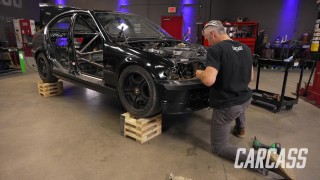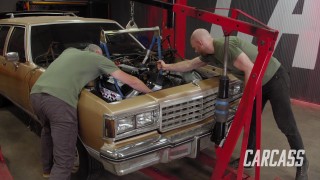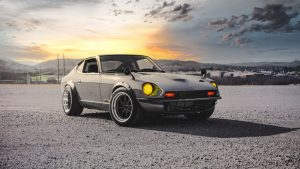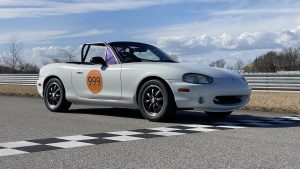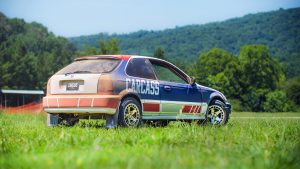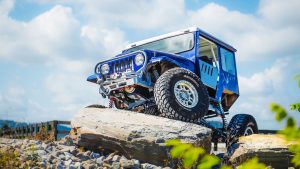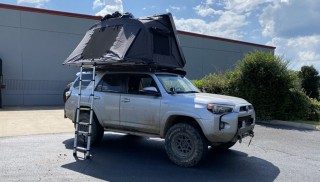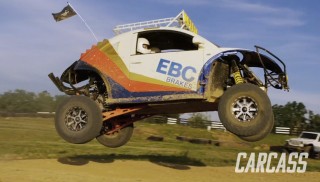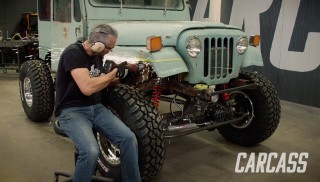Carcass Featured Projects
Carcass Builds
Want more content like this?
Join the PowerNation Email NewsletterVideo Transcript
(Jeremy)>> You're watching Powernation!
(Jeremy)>> Today on Carcass it's time for us to build a new tool for our shop. We'll show you how to fabricate and assemble a running engine stand.
(Jimmy)>> Plus give you some helpful tips on wiring up your power plant and dialing it in before dropping it into your next project. [ Music ] [ engine revving ] [ Music ]
(Jeremy)>> Hey guys, welcome to Carcass. Well today it's all about tech and fabrication, and it doesn't matter if you're a Mopar guy, if you're a GM guy, or even if you're a Ford guy. You know there's nothing better than hearing your engine fire up for the very first time. So today we're gonna fabricate a running engine stand, and all the parts and pieces that you're gonna need to pull this off can easily be grafted into your finished project. We went to Summit Racing and we just kinda picked up the basics. We got stuff like a fuel pump and some spark plugs wires. We've got some gauges to watch our vitals. Got to find a way to spin it over. So, we got a starter, and we've even got what we need to cool this thing down. Now how do you go about building something like this? It's pretty simple. You're gonna need to build a frame to set your engine in to, and that all starts with some steel.
(Jimmy)>> And around our shop we've got plenty of steel. Over the years this stuff has kinda accumulated on our storage rack, and mostly what we deal with is round tube building roll cages and things like that, but some of this rectangular stuff we just haven't really had a use for it. So, it sat here for a long time, but now we do have a use for it and it's a little bit overkill, but it's got nice flat edges. It's easy to fabricate with, and later on we'll be able to put castors on it to roll our engine cart around. [ Music ]
(Jeremy)>> Alright, I moved everything out of the way so you've got a nice, clean working space.
(Jimmy)>> Alright, I'll take some measurements and start cutting. [ Music ] The way we determine the measurements for our engine stand is pretty simple. Just needs to be long enough to accommodate a radiator and a gauge panel in front of the engine, and just wide enough to make sure the whole thing is stable. So, we're gonna end up at four and a half by three feet. [ Music ] We'll be using two by four .120-wall rectangular tubing. It's a little bit overkill but that's what we had laying around. With the tubes cut I'll lay them out on the table and put down a few tack welds. [ welder crackling ]
(Jimmy)>> And then fully weld it up. [ welder crackling ] [ Music ]
(Jimmy)>> I'll grind the welds down on the bottom to accommodate the castors. [ grinder buzzing ]
(Jimmy)>> To make our cart mobile we're gonna be using a set of four castors that we got from the local hardware store. We will be welding these on in each corner, but just so we don't have part of the castor just hanging off like this I made little tabs to go in here, and it's more of an aesthetic thing than anything else. So, we'll get these welded on and then we'll weld on the castors. [ welder crackling ] [ grinder buzzing ]
(Jimmy)>> For the castors I'm not going to weld all the way around each one. Instead, I'm just gonna lay down a few stitch welds. Alright so I've got the base all done. I've just got to get it on the ground so we can put the engine over it, use the forklift to do that. Then we can kinda build the mounts and figure out how we're gonna attach this all together.
(Jeremy)>> Alrighty!
I'll go grab the engine! [ Music ]
(Jeremy)>> Alright, let's get it in over the top. You just kinda tell me when.
(Jimmy)>> Yeah, we'll just move the bottom around and kinda figure that out. A little more. That's good!
(Jeremy)>>> Alright, so you have a basic plan on how you're gonna set this up, right?
(Jimmy)>> Yeah, we'll need to cut a few more tubes. We use those to kinda build mounts for the engine, and then we'll have another plate back here to mount the bell housing.
(Jeremy)>> It's gonna be somewhat universal?
(Jimmy)>> Yep, so I'll cut some stuff out on the plasma. If you want to cut some more tubes. Do you want to go higher, lower?
(Jeremy)>> Let's grab a tape measure and we'll just figure it out. Probably a good working height. This seems decent, right? I'll grab a tape measure. [ torch hissing ]
(Jimmy)>> I'll cut out the bell housing plate on the plasma table as well as our engine stand brackets. [ torch hissing ]
(Jeremy)>> You got your pieces cut?
(Jimmy)>> Yep!
(Jeremy)>> I've got a bunch of these cut as well.
(Jimmy)>> I'll bolt this plate on here, and then we'll just start tacking tubes on. See where our mounts land. [ Music ] With the rest of our tubes cut out, we'll finish constructing the engine stand. [ welder crackling ] [ Music ]
(Jimmy)>> We almost have the engine mounts made, and one thing that we did to make this whole thing universal is we made these plates here. So, on the sides this one's permanent to the stand itself. This one will bolt on here. And then we did make one to go on the engine mount itself, and then we just have to bridge the gap. So, what this does is any time you have a Ford engine like this you just take the mounts you already made, put it on. If you have an LS engine you'll have to make a brand new pair, but once you make it once you don't have to make another one. [ Music ] [ welder crackling ]
(Jimmy)>> That takes care of the engine stand itself. We'll get this thing off here, fully weld it, and then we'll move on to mounting the fuel cell, battery and some gauges.
(Jeremy)>> We've got the framework done. Now it's time to add some space for our fuel and power accessories.
(Jeremy)>> Alright guys, well Jimmy has the engine stand fully welded. We've got a couple more things that we do have to put on here before we fire it up.
(Jimmy)>> And that includes a battery, fuel cell, and a radiator, and we will also throw in some gauges just to keep an eye on everything.
(Jeremy)>> And if you want to tackle mounting up the battery, I'll take care of mounting the fuel cell, and then we'll get the radiator and the gauges in. [ Music ] We'll go about 26 on that. A small piece of square tubing will work just fine for the bottom of the fuel cell. [ welder crackling ]
(Jeremy)>> Okay, so with that bar on here that'll give me a little stand for the fuel cell to sit on to, and then what I'm gonna do is weld on a couple of tabs to the tank itself. That'll give us two more attachment points on the side here. So, a couple of marks and I'll go weld on some tabs.
(Jimmy)>> I've got my little battery tray made up. It's very simple. So, I'm just gonna weld this in here, and then I've also got a little support piece just to make sure this thing doesn't flex too much cause the battery does weigh quite a bit. [ welder crackling ] [ Music ]
(Jeremy)>> On the side I'll weld on a couple of small mounting tabs. [ Music ] And once it's set back on the engine stand I'll drill some holes and install some riv-nuts. [ drill humming ] [ Music ]
(Jeremy)>> Alright, that wraps up the battery and the fuel cell mount. Now we will grab a piece of tubing. We're gonna bend up a big hoop here and that's gonna mount our radiator. [ saw buzzing ]
(Jeremy)>> For the framework we're using inch and a half tubing. Alright, let's see how this fits. If my measurements were right we should land perfect, and we are. We can go ahead and set up the welder here quick, and we'll pack this in. [ welder crackling ]
(Jeremy)>> Alright, so we'll also tack in this cross bar. This will start building up the framework for our radiator. [ metal banging ] [ welder crackling ] [ drill humming ] [ Music ]
(Jeremy)>> I'll add a piece of aluminum to the bottom to make the lower radiator mount, and the same goes for the top. [ Music ] Alright, that's got our radiator mounted pretty solid there. The next thing we're gonna do before we get this thing ready to fire up is we're actually gonna build a little stand with a piece of aluminum on the top. That way we can put all of our gauges in there, and the key switch, and the essentials we need to fire this thing up. So, we'll take a couple of measurements and then I'll go cut some strap. [ mechanical humming ] [ welder crackling ]
(Jeremy)>> Okay, these stands are for this dash panel here. This is gonna house all of our gauges, and whatever we need to make the engine run. It's pretty simple. We'll just drill a bunch of holes in that, but for now I've got to finish welding this whole thing up.
(Jimmy)>> Coming up, we put the final touches on our engine stand and give you some simple wiring tech to get it running.
(Jeremy)>> Our running engine stand is coming along rather nicely. We've got a bunch of the big parts on it, but up here on the dash we've added a couple more smaller things. We've got stuff like our ignition box. We've got our hand throttle, a bunch of gauges, and we've got our coil pack, but this isn't everything we need to get this thing started. Jimmy's got a couple more hard parts to put on the engine.
(Jimmy)>> And the first thing is our Power Master starter. [ Music ] With the starter installed we have a few more things to add on before we can get the engine going. One of them being a starter relay. This is an older Ford style starter. So, you do need one of these to command it, and you also have an ignition switch, and if you want to get fancy we have a push button as well. I'm gonna start here with the relay. I think we're gonna mount it somewhere on the inside here. So, I've got to grab a drill and drill a couple of holes. [ drill humming ] [ Music ]
(Jimmy)>> After drilling some holes I'll put in a couple of nut inserts for Duralast Gold starter relay. [ Music ] Duralast offers global coverage for import and domestic applications. Their designs meet or exceed the specifications to ensure fast and easy installation, superior performance, and reliability. To make sure we don't have any problems in the future Duralast parts are a no brainer for our engine stand. Next two things, fuel pump and the regulator. [ Music ] For the fuel pump I'll attach it with the included hardware, and for the pressure regulator I'll drill two holes and use some more nut inserts. [ Music ] [ ratchet clicking ]
(Jeremy)>> Well now that Jimmy has some of the parts and pieces on the stand, we're gonna move on to some wiring. First place we're gonna start is right here with this Duralast ignition switch, and that's gonna go right up here on the dash. [ drill humming ]
(Jeremy)>> Okay, so this is the first step in our wiring endeavor that we're gonna on here. And you know there's a lot of those old timer guys out there that talk about how easy it is to wire up a carbureted engine, or the fact that you only need so many wires to get it to run, and it is pretty simple. Let me show you what I'm talking about. Now when you're getting ready to wire up your project or something like this it's a good idea to have a diagram or a schematic. Now since we're wiring ours from scratch I went ahead and drew one up. There's four major pieces that we're worried about. Obviously, we have our starter, got a battery, our start switch or our key switch. We also have our ignition system. We're gonna focus here on our start switch. Now off the back of that you're gonna have four pins. First pin's gonna ready battery. Obviously, that's gonna go to our battery. Second pin's gonna read ignition. Now that can go directly to your coil, or in our case it's gonna go to our ignition box. You're gonna have a start pin on the back. That can go right down to the starter, or again in our case it's gonna go down to our starter relay, and you're also gonna have an accessory pin. That's gonna control stuff like your lights, your gauges, and your radio. Now all those old guys were right. It really doesn't take a lot of wires to pull this off. In our case we have 10 or 12, and where we are gonna start is right down here at the battery. [ Music ] I'll start by making connections to the starter relay. Then move on to the starter itself. Up next is the ignition switch. Then we'll follow that up by wiring the ignition box, the coil... [ Music ] ...and the crank trigger. Alright, that wraps up the bulk of the wiring from here. I've got a wire in the gauges, and the tach, and stuff. We'll also tackle the fuel system. We'll be one step closer to firing this thing up. Up next, we'll show you how to make sure your engine is right on time.
(Jimmy)>> Jeremy and I took care of a few things and now we are ready to go. The Engine Power guys, when they build their engines they deliver them ready to fire up, but we wanted to take this opportunity to show you guys how to put this thing in time because this engine from what I hear is a little bit special.
(Frankie)>> First off, good job with the stand. This is actually really cool. We wanted something like this for a while. So, we might steal it when you're done. This one's a little bit different because it's a crank trigger ignition system. So normally you have a magnetic pick up inside the distributor that tells the ignition box when to fire the coil. In this sense it's actually a trigger that's on the crank shaft. So, it's a little bit more accurate for higher r-p-m stuff, which is what this engine was designed to do.
(Pat)>> Now this is the distributor, all it's doing is distributing spark. The pick-up is non-functional. You can see it's not plugged in, and the plug-in for the MSD goes into the actual trigger on the crank itself. Now there is some phasing that we can show because you can get this wrong. Even though this doesn't do anything it has to do it at the right time. You have to make sure that the spark is going where it's supposed to when it's supposed to.
(Jimmy)>> So you're taking the cap off. You're gonna take the spark plug out. So, what are you guys trying to accomplish here?
(Pat)>> You have to prove the thing is on number one. We base everything off of number one cylinder. That's how you base your firing order. So, we have to ensure that it's on number. Obviously, this is all together, and it would probably run if you just put wires on it but to show that it actually is on number one we're gonna pull it out. The distributor rotor rotates counterclockwise on this one. So, we're gonna pull this plug, and we're gonna rotate the engine until air pushes your finger out. That means both valves are closed and it's on a compression stroke on number one. The majority of times you see something blow fire out the top of the engine it's because they have the timing wrong, and typically they'll put it on t-d-c but it'll be on overlap, meaning both valves are open. One is almost closed and one just opened. So, fire gets back up into the induction system. So, what I'm gonna do is turn it over.
Hear that? Okay so that's coming up. Now what I'll do is I'll look down at the balancer and there will be timing marks on it. So, I'll get the timing marks close to where I want them. So, we're coming up on timing marks. That's a 40, there's 38. That's about 32 degrees. Okay, so now that that's there. That's 32-ish. This engine probably has a little bit more but we're gonna point the rotor in the area where we have the terminal's position marked on the actual distributor body.
(Frankie)>> And the body is loose already. It's really close, a little bit off. All you have to do is just turn it so that the rotor and the terminal inside the cap are lined dead up.
(Pat)>> Being it's phase able you can actually get it one way. It'll still work no matter what. It's being told to fire down here. So, it will fire whenever that magnet passes by that non-magnetic pick-up. So, you can get the rotor phasing off one way or another and it'll still run, but it'll be so far off. Sometimes it'll try to pick which cylinder. It'll fire on the wrong cycle. It's important if you do a lot of Chevys remember that you're doing a Ford because it rotates counterclockwise instead of clockwise, and obviously it's important to know the firing order. Small block Fords have two different firing orders depending on what year they are and what engine it is. They're still small blocks but the older 302s, 289s were different. They're the same as the big blocks and things like that. So, this particular one is a Windsor. So, it is one-three-seven-two, six-five-four-eight.
(Jimmy)>> And it's also numbered different. Like Fords are numbered one-two-three-four.
(Pat)>> The cylinders are one, two, three, four, five, six, seven, eight. It's very, very confusing if you don't work on a lot of them. As long as you get everything right it should fire right up.
(Jimmy)>> Wire's on!
(Pat)>> Now the all important hook-up from the coil to the top of the distributor.
(Frankie)>> You guys got water in this?
(Jimmy)>> Yep!
(Frankie)>> Got good fuel pressure?
(Jimmy)>> Yep!
(Pat)>> All that being said. If everything's plugged in you do the honors.
(Jimmy)>> Here we go! [ engine starts ] [ engine idling ]
(Jeremy)>> I'm not a Ford guy but this is the best sounding engine I think that's in this building.
(Pat)>> You're not a Ford guy?
(Jeremy)>> We're obviously Chevy guys, but this thing sounds amazing!
(Frankie)>> This is a spicy unit. It's a really nice engine. You guys must have done something right cause it runs, it doesn't leak.
(Pat)>> The fact that the fuel pump fired up, the starter works, it doesn't make any weird grinding noise. A lot of people when they don't have a dyno or something like that this is a great option to make sure something runs, doesn't leak, wiring, break-in process.
(Frankie)>> We have a big collection of engines. So now we can put whatever we want on it, which is cool.
(Jimmy)>> Let's get some heat in it.
(Jeremy)>> I want to hear it again.
(Pat)>> Fire it back up.
(Jeremy)>> Rev it up once! [ engine starting and revving ]
(Jeremy)>> That's gonna wrap it up for us today. You guys like anything you've see check us out at Powernation TV.
Show Full Transcript
(Jeremy)>> Today on Carcass it's time for us to build a new tool for our shop. We'll show you how to fabricate and assemble a running engine stand.
(Jimmy)>> Plus give you some helpful tips on wiring up your power plant and dialing it in before dropping it into your next project. [ Music ] [ engine revving ] [ Music ]
(Jeremy)>> Hey guys, welcome to Carcass. Well today it's all about tech and fabrication, and it doesn't matter if you're a Mopar guy, if you're a GM guy, or even if you're a Ford guy. You know there's nothing better than hearing your engine fire up for the very first time. So today we're gonna fabricate a running engine stand, and all the parts and pieces that you're gonna need to pull this off can easily be grafted into your finished project. We went to Summit Racing and we just kinda picked up the basics. We got stuff like a fuel pump and some spark plugs wires. We've got some gauges to watch our vitals. Got to find a way to spin it over. So, we got a starter, and we've even got what we need to cool this thing down. Now how do you go about building something like this? It's pretty simple. You're gonna need to build a frame to set your engine in to, and that all starts with some steel.
(Jimmy)>> And around our shop we've got plenty of steel. Over the years this stuff has kinda accumulated on our storage rack, and mostly what we deal with is round tube building roll cages and things like that, but some of this rectangular stuff we just haven't really had a use for it. So, it sat here for a long time, but now we do have a use for it and it's a little bit overkill, but it's got nice flat edges. It's easy to fabricate with, and later on we'll be able to put castors on it to roll our engine cart around. [ Music ]
(Jeremy)>> Alright, I moved everything out of the way so you've got a nice, clean working space.
(Jimmy)>> Alright, I'll take some measurements and start cutting. [ Music ] The way we determine the measurements for our engine stand is pretty simple. Just needs to be long enough to accommodate a radiator and a gauge panel in front of the engine, and just wide enough to make sure the whole thing is stable. So, we're gonna end up at four and a half by three feet. [ Music ] We'll be using two by four .120-wall rectangular tubing. It's a little bit overkill but that's what we had laying around. With the tubes cut I'll lay them out on the table and put down a few tack welds. [ welder crackling ]
(Jimmy)>> And then fully weld it up. [ welder crackling ] [ Music ]
(Jimmy)>> I'll grind the welds down on the bottom to accommodate the castors. [ grinder buzzing ]
(Jimmy)>> To make our cart mobile we're gonna be using a set of four castors that we got from the local hardware store. We will be welding these on in each corner, but just so we don't have part of the castor just hanging off like this I made little tabs to go in here, and it's more of an aesthetic thing than anything else. So, we'll get these welded on and then we'll weld on the castors. [ welder crackling ] [ grinder buzzing ]
(Jimmy)>> For the castors I'm not going to weld all the way around each one. Instead, I'm just gonna lay down a few stitch welds. Alright so I've got the base all done. I've just got to get it on the ground so we can put the engine over it, use the forklift to do that. Then we can kinda build the mounts and figure out how we're gonna attach this all together.
(Jeremy)>> Alrighty!
I'll go grab the engine! [ Music ]
(Jeremy)>> Alright, let's get it in over the top. You just kinda tell me when.
(Jimmy)>> Yeah, we'll just move the bottom around and kinda figure that out. A little more. That's good!
(Jeremy)>>> Alright, so you have a basic plan on how you're gonna set this up, right?
(Jimmy)>> Yeah, we'll need to cut a few more tubes. We use those to kinda build mounts for the engine, and then we'll have another plate back here to mount the bell housing.
(Jeremy)>> It's gonna be somewhat universal?
(Jimmy)>> Yep, so I'll cut some stuff out on the plasma. If you want to cut some more tubes. Do you want to go higher, lower?
(Jeremy)>> Let's grab a tape measure and we'll just figure it out. Probably a good working height. This seems decent, right? I'll grab a tape measure. [ torch hissing ]
(Jimmy)>> I'll cut out the bell housing plate on the plasma table as well as our engine stand brackets. [ torch hissing ]
(Jeremy)>> You got your pieces cut?
(Jimmy)>> Yep!
(Jeremy)>> I've got a bunch of these cut as well.
(Jimmy)>> I'll bolt this plate on here, and then we'll just start tacking tubes on. See where our mounts land. [ Music ] With the rest of our tubes cut out, we'll finish constructing the engine stand. [ welder crackling ] [ Music ]
(Jimmy)>> We almost have the engine mounts made, and one thing that we did to make this whole thing universal is we made these plates here. So, on the sides this one's permanent to the stand itself. This one will bolt on here. And then we did make one to go on the engine mount itself, and then we just have to bridge the gap. So, what this does is any time you have a Ford engine like this you just take the mounts you already made, put it on. If you have an LS engine you'll have to make a brand new pair, but once you make it once you don't have to make another one. [ Music ] [ welder crackling ]
(Jimmy)>> That takes care of the engine stand itself. We'll get this thing off here, fully weld it, and then we'll move on to mounting the fuel cell, battery and some gauges.
(Jeremy)>> We've got the framework done. Now it's time to add some space for our fuel and power accessories.
(Jeremy)>> Alright guys, well Jimmy has the engine stand fully welded. We've got a couple more things that we do have to put on here before we fire it up.
(Jimmy)>> And that includes a battery, fuel cell, and a radiator, and we will also throw in some gauges just to keep an eye on everything.
(Jeremy)>> And if you want to tackle mounting up the battery, I'll take care of mounting the fuel cell, and then we'll get the radiator and the gauges in. [ Music ] We'll go about 26 on that. A small piece of square tubing will work just fine for the bottom of the fuel cell. [ welder crackling ]
(Jeremy)>> Okay, so with that bar on here that'll give me a little stand for the fuel cell to sit on to, and then what I'm gonna do is weld on a couple of tabs to the tank itself. That'll give us two more attachment points on the side here. So, a couple of marks and I'll go weld on some tabs.
(Jimmy)>> I've got my little battery tray made up. It's very simple. So, I'm just gonna weld this in here, and then I've also got a little support piece just to make sure this thing doesn't flex too much cause the battery does weigh quite a bit. [ welder crackling ] [ Music ]
(Jeremy)>> On the side I'll weld on a couple of small mounting tabs. [ Music ] And once it's set back on the engine stand I'll drill some holes and install some riv-nuts. [ drill humming ] [ Music ]
(Jeremy)>> Alright, that wraps up the battery and the fuel cell mount. Now we will grab a piece of tubing. We're gonna bend up a big hoop here and that's gonna mount our radiator. [ saw buzzing ]
(Jeremy)>> For the framework we're using inch and a half tubing. Alright, let's see how this fits. If my measurements were right we should land perfect, and we are. We can go ahead and set up the welder here quick, and we'll pack this in. [ welder crackling ]
(Jeremy)>> Alright, so we'll also tack in this cross bar. This will start building up the framework for our radiator. [ metal banging ] [ welder crackling ] [ drill humming ] [ Music ]
(Jeremy)>> I'll add a piece of aluminum to the bottom to make the lower radiator mount, and the same goes for the top. [ Music ] Alright, that's got our radiator mounted pretty solid there. The next thing we're gonna do before we get this thing ready to fire up is we're actually gonna build a little stand with a piece of aluminum on the top. That way we can put all of our gauges in there, and the key switch, and the essentials we need to fire this thing up. So, we'll take a couple of measurements and then I'll go cut some strap. [ mechanical humming ] [ welder crackling ]
(Jeremy)>> Okay, these stands are for this dash panel here. This is gonna house all of our gauges, and whatever we need to make the engine run. It's pretty simple. We'll just drill a bunch of holes in that, but for now I've got to finish welding this whole thing up.
(Jimmy)>> Coming up, we put the final touches on our engine stand and give you some simple wiring tech to get it running.
(Jeremy)>> Our running engine stand is coming along rather nicely. We've got a bunch of the big parts on it, but up here on the dash we've added a couple more smaller things. We've got stuff like our ignition box. We've got our hand throttle, a bunch of gauges, and we've got our coil pack, but this isn't everything we need to get this thing started. Jimmy's got a couple more hard parts to put on the engine.
(Jimmy)>> And the first thing is our Power Master starter. [ Music ] With the starter installed we have a few more things to add on before we can get the engine going. One of them being a starter relay. This is an older Ford style starter. So, you do need one of these to command it, and you also have an ignition switch, and if you want to get fancy we have a push button as well. I'm gonna start here with the relay. I think we're gonna mount it somewhere on the inside here. So, I've got to grab a drill and drill a couple of holes. [ drill humming ] [ Music ]
(Jimmy)>> After drilling some holes I'll put in a couple of nut inserts for Duralast Gold starter relay. [ Music ] Duralast offers global coverage for import and domestic applications. Their designs meet or exceed the specifications to ensure fast and easy installation, superior performance, and reliability. To make sure we don't have any problems in the future Duralast parts are a no brainer for our engine stand. Next two things, fuel pump and the regulator. [ Music ] For the fuel pump I'll attach it with the included hardware, and for the pressure regulator I'll drill two holes and use some more nut inserts. [ Music ] [ ratchet clicking ]
(Jeremy)>> Well now that Jimmy has some of the parts and pieces on the stand, we're gonna move on to some wiring. First place we're gonna start is right here with this Duralast ignition switch, and that's gonna go right up here on the dash. [ drill humming ]
(Jeremy)>> Okay, so this is the first step in our wiring endeavor that we're gonna on here. And you know there's a lot of those old timer guys out there that talk about how easy it is to wire up a carbureted engine, or the fact that you only need so many wires to get it to run, and it is pretty simple. Let me show you what I'm talking about. Now when you're getting ready to wire up your project or something like this it's a good idea to have a diagram or a schematic. Now since we're wiring ours from scratch I went ahead and drew one up. There's four major pieces that we're worried about. Obviously, we have our starter, got a battery, our start switch or our key switch. We also have our ignition system. We're gonna focus here on our start switch. Now off the back of that you're gonna have four pins. First pin's gonna ready battery. Obviously, that's gonna go to our battery. Second pin's gonna read ignition. Now that can go directly to your coil, or in our case it's gonna go to our ignition box. You're gonna have a start pin on the back. That can go right down to the starter, or again in our case it's gonna go down to our starter relay, and you're also gonna have an accessory pin. That's gonna control stuff like your lights, your gauges, and your radio. Now all those old guys were right. It really doesn't take a lot of wires to pull this off. In our case we have 10 or 12, and where we are gonna start is right down here at the battery. [ Music ] I'll start by making connections to the starter relay. Then move on to the starter itself. Up next is the ignition switch. Then we'll follow that up by wiring the ignition box, the coil... [ Music ] ...and the crank trigger. Alright, that wraps up the bulk of the wiring from here. I've got a wire in the gauges, and the tach, and stuff. We'll also tackle the fuel system. We'll be one step closer to firing this thing up. Up next, we'll show you how to make sure your engine is right on time.
(Jimmy)>> Jeremy and I took care of a few things and now we are ready to go. The Engine Power guys, when they build their engines they deliver them ready to fire up, but we wanted to take this opportunity to show you guys how to put this thing in time because this engine from what I hear is a little bit special.
(Frankie)>> First off, good job with the stand. This is actually really cool. We wanted something like this for a while. So, we might steal it when you're done. This one's a little bit different because it's a crank trigger ignition system. So normally you have a magnetic pick up inside the distributor that tells the ignition box when to fire the coil. In this sense it's actually a trigger that's on the crank shaft. So, it's a little bit more accurate for higher r-p-m stuff, which is what this engine was designed to do.
(Pat)>> Now this is the distributor, all it's doing is distributing spark. The pick-up is non-functional. You can see it's not plugged in, and the plug-in for the MSD goes into the actual trigger on the crank itself. Now there is some phasing that we can show because you can get this wrong. Even though this doesn't do anything it has to do it at the right time. You have to make sure that the spark is going where it's supposed to when it's supposed to.
(Jimmy)>> So you're taking the cap off. You're gonna take the spark plug out. So, what are you guys trying to accomplish here?
(Pat)>> You have to prove the thing is on number one. We base everything off of number one cylinder. That's how you base your firing order. So, we have to ensure that it's on number. Obviously, this is all together, and it would probably run if you just put wires on it but to show that it actually is on number one we're gonna pull it out. The distributor rotor rotates counterclockwise on this one. So, we're gonna pull this plug, and we're gonna rotate the engine until air pushes your finger out. That means both valves are closed and it's on a compression stroke on number one. The majority of times you see something blow fire out the top of the engine it's because they have the timing wrong, and typically they'll put it on t-d-c but it'll be on overlap, meaning both valves are open. One is almost closed and one just opened. So, fire gets back up into the induction system. So, what I'm gonna do is turn it over.
Hear that? Okay so that's coming up. Now what I'll do is I'll look down at the balancer and there will be timing marks on it. So, I'll get the timing marks close to where I want them. So, we're coming up on timing marks. That's a 40, there's 38. That's about 32 degrees. Okay, so now that that's there. That's 32-ish. This engine probably has a little bit more but we're gonna point the rotor in the area where we have the terminal's position marked on the actual distributor body.
(Frankie)>> And the body is loose already. It's really close, a little bit off. All you have to do is just turn it so that the rotor and the terminal inside the cap are lined dead up.
(Pat)>> Being it's phase able you can actually get it one way. It'll still work no matter what. It's being told to fire down here. So, it will fire whenever that magnet passes by that non-magnetic pick-up. So, you can get the rotor phasing off one way or another and it'll still run, but it'll be so far off. Sometimes it'll try to pick which cylinder. It'll fire on the wrong cycle. It's important if you do a lot of Chevys remember that you're doing a Ford because it rotates counterclockwise instead of clockwise, and obviously it's important to know the firing order. Small block Fords have two different firing orders depending on what year they are and what engine it is. They're still small blocks but the older 302s, 289s were different. They're the same as the big blocks and things like that. So, this particular one is a Windsor. So, it is one-three-seven-two, six-five-four-eight.
(Jimmy)>> And it's also numbered different. Like Fords are numbered one-two-three-four.
(Pat)>> The cylinders are one, two, three, four, five, six, seven, eight. It's very, very confusing if you don't work on a lot of them. As long as you get everything right it should fire right up.
(Jimmy)>> Wire's on!
(Pat)>> Now the all important hook-up from the coil to the top of the distributor.
(Frankie)>> You guys got water in this?
(Jimmy)>> Yep!
(Frankie)>> Got good fuel pressure?
(Jimmy)>> Yep!
(Pat)>> All that being said. If everything's plugged in you do the honors.
(Jimmy)>> Here we go! [ engine starts ] [ engine idling ]
(Jeremy)>> I'm not a Ford guy but this is the best sounding engine I think that's in this building.
(Pat)>> You're not a Ford guy?
(Jeremy)>> We're obviously Chevy guys, but this thing sounds amazing!
(Frankie)>> This is a spicy unit. It's a really nice engine. You guys must have done something right cause it runs, it doesn't leak.
(Pat)>> The fact that the fuel pump fired up, the starter works, it doesn't make any weird grinding noise. A lot of people when they don't have a dyno or something like that this is a great option to make sure something runs, doesn't leak, wiring, break-in process.
(Frankie)>> We have a big collection of engines. So now we can put whatever we want on it, which is cool.
(Jimmy)>> Let's get some heat in it.
(Jeremy)>> I want to hear it again.
(Pat)>> Fire it back up.
(Jeremy)>> Rev it up once! [ engine starting and revving ]
(Jeremy)>> That's gonna wrap it up for us today. You guys like anything you've see check us out at Powernation TV.







